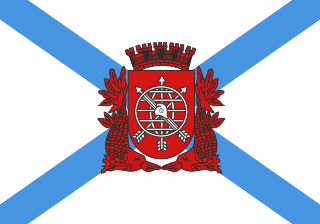
Copacabana is a bairro (neighbourhood) located in the South Zone of the city of Rio de Janeiro, Brazil. It is most prominently known for its 4 km (2.5 miles) balneario beach, which is one of the most famous in the world.

Rio de Janeiro, or simply Rio, is the capital of the state of Rio de Janeiro, and the second-most-populous city in Brazil, after São Paulo. Listed by the GaWC as a beta global city, Rio de Janeiro is the sixth most populous city in the Americas. Part of the city has been designated as a World Heritage Site, named "Rio de Janeiro: Carioca Landscapes between the Mountain and the Sea", on 1 July 2012 as a Cultural Landscape.

Hilton Worldwide Holdings Inc. is an American multinational hospitality company that manages and franchises a broad portfolio of hotels and resorts. Founded by Conrad Hilton in May 1919, the company is now led by Christopher J. Nassetta. Hilton is headquartered in Tysons, Virginia, United States.

Leme is an upper-middle-class neighborhood in the South Zone of the City of Rio de Janeiro, Brazil, next to Copacabana, Urca and Botafogo. The neighborhood takes its name from a nearby rock formation whose shape resembles the rudder of a ship.

Le Méridien New Orleans is a 23-story high-rise building in the Central Business District of New Orleans, Louisiana. The building rises 279 feet, and is currently tied with Charity Hospital as the 29th-tallest building in the city. It also stands as the 8th-tallest hotel in New Orleans.

The 1995 Beach Soccer World Championships was the first edition of the Beach Soccer World Championships, the most prestigious competition in international beach soccer contested by men's national teams until 2005, when the competition was then replaced by the second iteration of a world cup in beach soccer, the better known FIFA Beach Soccer World Cup. It was organised by Brazilian sports agency Koch Tavares.

The Morro da Babilônia is a hill in the Leme neighbourhood of Rio de Janeiro, separating Copacabana beach from Botafogo. It is home to a favela known by the same name, as well as the favela Chapéu Mangueira. Morro da Babilônia is an environmentally protected area.

The Hotel Glória was a grand hotel in the Glória neighbourhood of Rio de Janeiro, Brazil. It was built by entrepreneur Rocha Miranda for the International Exhibition of 1922 to commemorate the centennial of Brazil's independence. It opened on August 15, 1922. The hotel was designed by Joseph Gire, who also designed the Copacabana Palace. It was reportedly the first reinforced concrete building to be built in South America and was erected with the aid of German engineers.

The South Zone is an area of the city of Rio de Janeiro situated between the Tijuca Massif, the Atlantic Ocean and Guanabara Bay. Most of it is made up of neighborhoods along the Atlantic coastline, such as São Conrado, Vidigal, Leblon, Ipanema, Copacabana, and Leme.

The Grand Nile Tower Hotel is located on Roda Island in Cairo, Egypt.
The Hotel Atlantico Praia, formerly the Ouro Verde Hotel, is a small hotel in Copacabana, Rio de Janeiro, Brazil. At one time the Ouro Verde was considered one of the world's best small hotels, and the restaurant had a high reputation. Over time it lost some of its lustre, but it has recently been renovated.

Avenida Atlântica is a major seaside avenue in Rio de Janeiro, Brazil. It is 4 kilometers long, and spans the entire length of the neighbourhoods of Copacabana and Leme.
The following is a timeline of the history of the city of Rio de Janeiro, Brazil.

Bike Itaú is a public bicycle sharing system in the city of Rio de Janeiro, Brazil. It is run by PBSC Urban Solutions and started on the 20th of February 2018, and is sponsored by the municipal government of Rio de Janeiro in partnership with Banco Itaú. The system replaces the old one, operated by Serttel a private concessionaire, that began operations in October 2011. The old bike sharing system had 4000 bicycles available at 400 rental stations located throughout several neighborhoods in the city. The rental stations are powered by solar panels.

Gregorio Byington Duvivier is a Brazilian actor, comedian and poet. He is known by his works in film and theater, being one of the members of the comedian troupe Porta dos Fundos.

Copacabana Palace, is a hotel in the city of Rio de Janeiro, Brazil, facing Copacabana beach. Designed by French architect Joseph Gire, it was built in a style that follows the line and model of the great beach hotels of the nineteenth and early twentieth centuries, and opened on August 13, 1923.

Park Hotels & Resorts is a real estate investment trust (REIT) focused on hotel properties, based in Tysons, Virginia. It was formed in 2017 as a spin-off from Hilton Worldwide.

The following outline is provided as an overview of and topical guide to Rio de Janeiro:
The Cinema Rian was a theatre in Rio de Janeiro, Brazil founded by artist and former first lady of Brazil Nair de Tefé in November 1932. The theatre was located in a well-to-do area on the Avenida Atlântica, Copacabana, facing the Atlantic Ocean. The theatre was considered one of the best-known in Rio de Janeiro before its demolition in 1983.
Elton Martinez Carvalho Leme is a Brazilian who is employed as a judge. He is also a self-taught botanist with a special interest in bromeliads. As of November 2022, the International Plant Names Index listed 629 scientific names which include Leme as a publishing author, including 13 generic names.

















